Welcome to Physics 3210!
Syllabus
We started class by going over the syllabus. Remember: you're responsible for knowing all of the contents of the syllabus, and it is subject to update through the semester. (Any such updates will be announced to the class and indicated on the syllabus page.)
A few words on learning
One topic that doesn't come up enough in classes, at least in my opinion, is the topic of how to effectively learn. You've all made it as far as this classroom, which certainly means you each have your own effective ways of approaching this problem. But I think it's useful to go over a couple of scientific ideas related to learning, which will also help me explain a couple of reasons why the class is structured as it is.
I'm just going to give a couple of high points, but if you feel like you want to delve deeper into the subject, I recommend the Coursera course "Learning How To Learn" as a lightweight but insightful set of material.
Our memory can hold an enormous amount of information, but the "working memory" containing what we are immediately and actively thinking about is limited to about four different pieces of information. I don't have a device policy in this class, as long as you don't disturb others. But just remember that you're using up a very finite resource if you're trying to focus on something unrelated to the class during lecture!
The human mind is very good at making connections and finding patterns. In fact, it's much easier to remember an association of closely-related items than it is to remember a jumble of unrelated individual facts. The kind of active thinking you do when solving a problem or clicker question in this class will help you to form these mental associations and better retain the material we cover!
It's much easier to convince yourself that you understand something which you haven't actually learned if you re-read the same explanation (this is known as the "illusion of competence".) This is why I don't post lecture notes until after class, and I encourage you to take your own notes, phrasing the concepts we cover in your own words. Confronting the same material in a slightly different way, as you hear lecture, read your own notes, read my notes, do the homework, etc. is the best way to solidify your own learning gains.
It takes time to learn something new; your brain is processing new facts in the background all the time. Try to avoid "cramming", or studying large chunks of material all at once - you'll retain what you learn much better if you space your learning time out!
I firmly believe that anyone can succeed in this class, as long as they put in the required time and effort.
Overview
Let's start with the big picture: what are the main new topics in mechanics we'll be studying this semester?
Lagrangian and Hamiltonian mechanics
This is where we will start. Lagrangian mechanics is a complete reformulation of classical mechanics, based on an entirely new physical principle ("least action") and a new mathematical framework (the calculus of variations.) Note that it's a reformulation, not an extension; Lagrangians describe the same physics as Newton's laws, and give the same answers.
The Lagrangian approach avoids the language of forces completely, in favor of dealing with energies. You already know that conservation of energy is much easier than balancing force vectors, when you can use it! Using the Lagrangian will make certain problems much easier, including some calculations we might not even attempt with Newton's laws. Problems with constrained motion, like a bead moving on a wire, are a classic example.
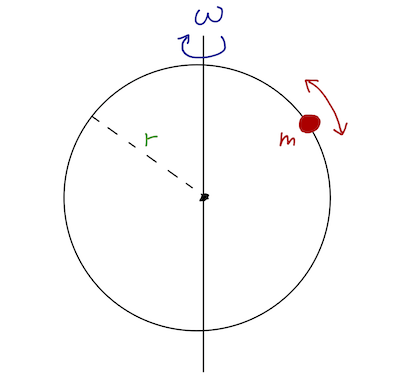
Hamiltonian mechanics is built on top of Lagrangian mechanics, a sort of reformulation of a reformulation. It's similar to the Lagrangian approach and not usually any easier to calculate with, but it can provide powerful insights into certain physical systems; we'll come back to it towards the end of the semester.
These are the most important topics we will study this semester, by far! The Lagrangian and Hamiltonian formalism isn't just a neat trick for solving mechanics problems; it lies at the core of most of modern physics. This formalism can be applied to electromagnetism, and is essential for quantum mechanics. \( L \) and \( H \) are fundamental to all of physics.
Central force motion
As our first practical application, we'll study central force motion in general, discovering what conditions can give rise to stable orbital motion and how to describe it. Both of the long-range forces we know of - gravity and electromagnetism - are central forces, so this is a more general subject than you might think!
That being said, we'll mainly focus on gravity as a central force, deriving Kepler's three laws and studying orbits in the solar system; everything from the motion of planets to more complicated motions, like orbital transfers.
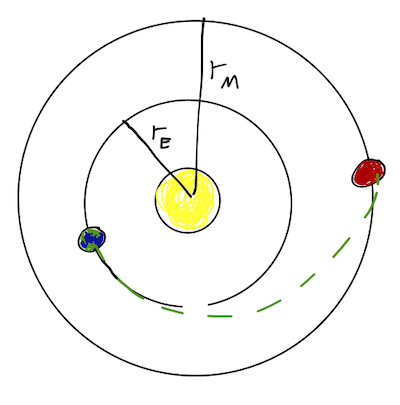
Non-inertial frames
Newton's laws are only valid is so-called "inertial frames"; that is, frames of reference which aren't being accelerated. We'll see how they can be modified to include the effects of an applied acceleration (which of course includes rotation, even at constant angular speed.)
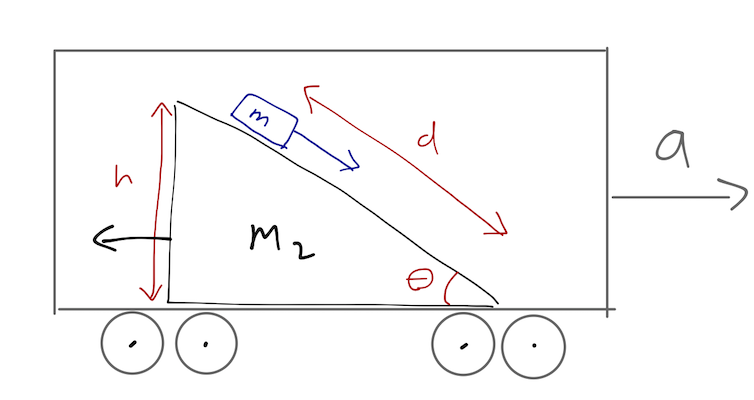
Of course, you can always describe the motion of a machine in an accelerating train car from the point of view of someone standing by the side of the tracks: in other words, Newton's laws always work as long as you take the bigger picture into account. But sometimes it's more convenient to work inside the accelerating system.
This is especially true when you remember that we live on a non-inertial system, namely a spinning Earth! We'll have a look at some of the specific, subtle mechanical effects that arise from this fact.
Rotation of rigid bodies
This is an easy subject to motivate: if you look around the room, you won't see any point particles! To a good approximation, everything around us is a rigid body, a collection of particles arranged into a particular shape. The fact that rigid bodies and rotational motion are so common makes this subject seem a little pedestrian, but a detailed knowledge of rotation angles is essential if you want to fly a plane, for example!
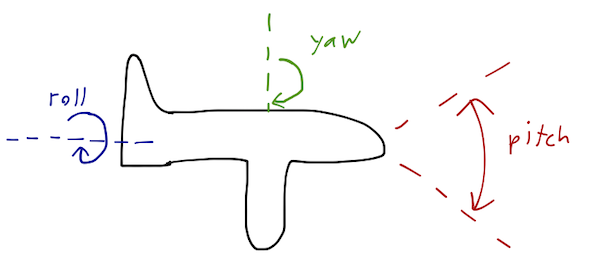
As you know, linear forces on an extended object act on the center of mass. In other words, when being pushed or pulled around, rigid bodies do act like point particles. The main complication we have to deal with is rotation, which involves motion of the collection of particles with respect to itself.
We'll derive some useful formalism, and go on to make general statements about how to predict rotational motion, including splitting objects into categories based on how symmetric their shape is. This subject will also give us a crash course in eigenvalue and eigenvector methods, which have a natural application in finding the axes around which a body will rotate stably.
Coupled harmonic oscillators
This is an even easier subject to motivate, although I can't quite say "look around you" since you can't see things on the atomic and molecular level. At that scale, a huge number of materials are well-described (to first approximation) by systems of coupled harmonic oscillators, anything from a single \( {\rm CO}_2 \) molecule up to a crystal lattice of many atoms.
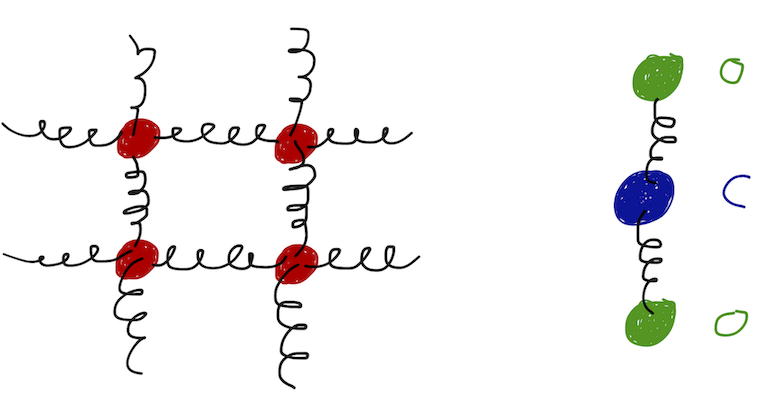
Aside from the physical applications, coupled harmonic oscillators will give us a nice system to learn more general techniques for dealing with coupled sets of differential equations.
And more...
There's a huge number of interesting special topics in classical mechanics, more than we can possibly get to in one semester! Continuum mechanics (the motion of waves) and nonlinear dynamics (chaos) are two subjects that we should be able to at least touch on in this class.
Conceptual pre-test
We ended with a conceptual pre-test, which will be used to keep track of some learning objectives in the course.